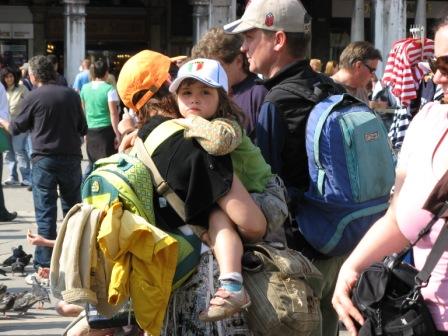Down on the island of Sant’ Elena, the last lobe of land at the eastern tip of Venice, is the Scuola Navale Militare (Naval Military School) Francesco Morosini.

It was founded in 1937, closed in 1945, then went through various versions till it was reopened in 1961. The school is named for one of the Venetian Republic’s greatest Captains-General, who held on to the Peloponnese while most of the rest of Venice’s Greek possessions were dropping like rotting olives into Ottoman hands. Yes, no point pretending we don’t know: He’s the one who ordered the cannons to fire on the Parthenon (September 26, 1687) during the siege of Athens, turning Athena’s temple into an instant ruin. Of course if the Ottomans hadn’t used the temple as an ammunition dump, none of that would have happened. The Republic made him doge a year later. You can see his stuffed cat in the Correr Museum. But back to the school.
“Morosini,” as we call the whole thing for short, is a three-year high school which till the end of this year was strictly for boys (this will change next fall — everyone is pretty keyed-up) and its students are, in fact, officially sworn into the Navy.
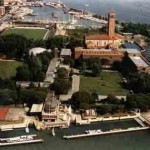
They wear the stars on their collars, they get paid a pittance, and they march and salute and haze each other and complain about their commanders and do everything else that military men do.
They also learn Venetian rowing, which is where Lino comes in. He’s been teaching this uniquely Venetian sport/skill/art/tradition to the boys here since 1994. Sailing was already part of their sports program, but Lino thought they ought to learn something that belonged to the place they were living. The Commandant took him up on his proposal, and so it has gone, ever since.

So that’s why we were invited, as we are every year, to the ceremony of the Swearing of Allegiance to flag and country by the boys who are finishing their first year. By this point any boy who’s likely to drop out has already done so, and the remaining first-year cadets — this year numbering 46 — have chosen a name for their class and ordered their banner. This is where it gets really good. Because they not only pledge fidelity to national and military values, but officially present their class banner to the Commandant, which the chaplain then blesses with holy water. Then they swear. Stay with me.
At this point, any reader who doesn’t have the slightest interest in the navy, the military, banners, oaths, or ceremony of any kind can be excused from the rest of this post. (They may already be gone.) On the whole, I wouldn’t have admitted to a particular interest in some of these elements, but now that I’ve gotten to know so many of the boys and their commanders, rowing or going out to dinner with them, that I have to say that I really love this event.
This is one occasion where the ceremonial isn’t the sort of “Hey, crack yourself a cold one” approach that you see at other events, such as the lowering of the flags in the Piazza San Marco on Sunday evening. And any time that the military demonstrates that it takes itself, its comrades, and its history, seriously, will virtually guarantee an event that impresses and moves me. The Navy Band, the oldest military band in Italy, is brought in from Rome just for the occasion, to play the appropriate pieces such as the Submariners’ Anthem, the Navy Anthem, and the national anthem. And if the speeches get boring, I can always watch the boys, as the sun rises toward noon and they start to collapse. This year there was a cool breeze and they all managed to stay vertical.
The class of 2011 chose the name “Ulixes” (as in Ulysses), and the motto is “Suae Quisque Fortunae Faber Est” which as you all know means “Every man is the architect of his own fortune,” a much-quoted observation of a certain Appius Claudius Caecus. 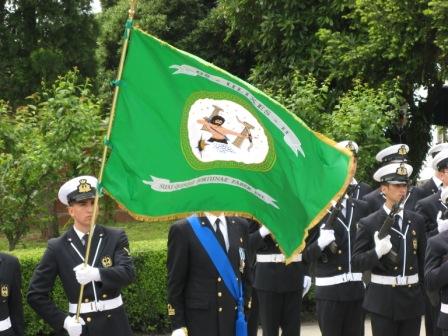
There are two high points in the ceremony for me. The first is the entrance of the class banners. There are more than 40 by now, of all sorts of colors and sizes and mottos and designs, and each is carried by one member of that class. Some of these individuals are not holding up quite as well as their banner, but it’s brilliant to see them all marching across to the martial music of the band.
(Above and above right): procession of class banners; (lower right), the Navy standard displaying copies of all the medals awarded either to ships or to individuals. It is kept by the National Association of Discharged Sailors.
The second great moment, naturally, is the oath-taking itself.
At the crucial moment, the Commandant orders “A me la bandiera!” (Give me the flag — he means the Italian flag). He grabs the flag on its pole and holds it up in front of the boys, all standing at attention. Then he pronounces the oath: “‘I swear to be faithful to the Italian Republic, to observe the Constitution and the Laws, and to fulfill with discipline and honor the duties of my State for the defense of the Motherland and the safeguarding of free institutions.’ Do you swear?”
What follows is something between a bellow and a roar: “I SWEAR!” It’s thrilling. It’s like something out of the “Oath of the Horatii.”
Then, of course, there’s lunch. As the saying here goes, “All the psalms finish with the Gloria,” meaning however whatever-the-thing-is may have gone (you remember that there are happy psalms and ghastly, garment-rending psalms), just about any gathering will finish with a feed. In case you might have felt any extreme emotions or thought any inappropriate thoughts along the way, this makes everything all better.
By now the buffet is as predictable as the speeches and the oath — and much less moving — but by this point we’re always famished so we don’t mind facing the same platters of prosciutto, skewers of mozzarella and cherry tomatoes, rice salad, some half-hearted pasta, assorted sandwiches, and so on. No no, I’m not complaining. Anything I don’t have to cook is fine with me.
Besides, it gives me a chance to review the assortment of mothers. There is quite a component of women who, where their garb and jewelry are concerned, will never, ever give up the ship.
Below is a small gallery of the assorted uniformed guests who gave the ceremony its sense of real importance.
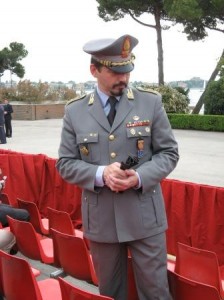
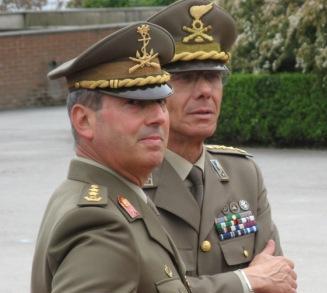
Veteran commando frogmen of the legendary “Decima,” or Tenth Assault Vehicle Flotilla. Their first operation was an attack on an Austrian warship on Nov. 1, 1918, making Italy the first ever to use frogmen and manned torpedoes, predating both the U.S. Navy SEALS and the British Royal Marines Special Boat Service. Their badge is crowned by a skull clenching a red rose in its teeth, symbolizing they have pledged themselves up to and including death. MAS stands for various phrases, some technical, but the best is their motto: “Memento Audere Semper,” or, “Remember always to dare.” Today the unit is known as COMSUBIN, which sounds dull even if you do say it in Italian.
(Above left) A captain of the mountain artillery, part of the Alpine regiment of the infantry. Troops carry a black raven’s feather in their cap; junior officers a brown eagle feather, and senior officers a white goose feather. Said Radio Moscow during World War 2, “Only the Alpini can claim to be undefeated on Russian soil.” (Above right) A general of the Carabinieri who is also a pilot, with a monsignor of the Military Ordinariate, a type of military chaplaincy.
Members of the National Association of Italian Partisans, who fought in the Resistance during World War 2. The subject of the partisans is still a highly-charged subject, politically and emotionally, and while they are always present at military ceremonies, they are never officially acknowledged.
Immediately after the oath is the singing of the national anthem. The emotional payload of the moment is clear; this may well be the only time they will ever sing this song with this much conviction.

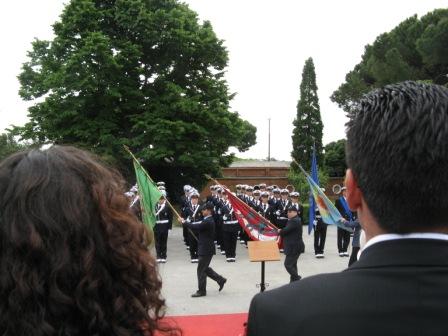
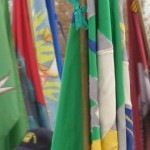
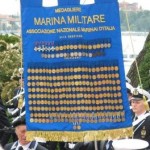
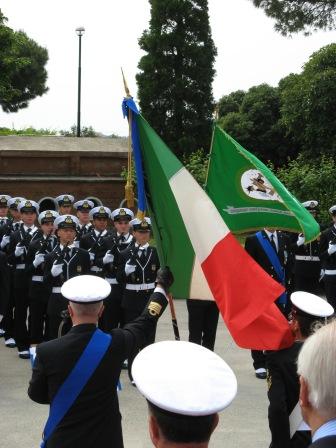


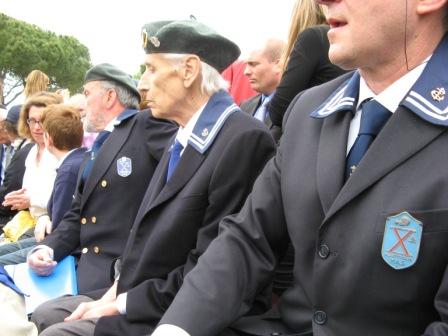

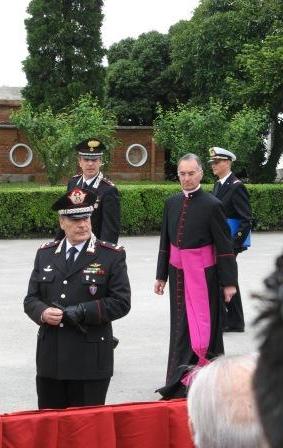
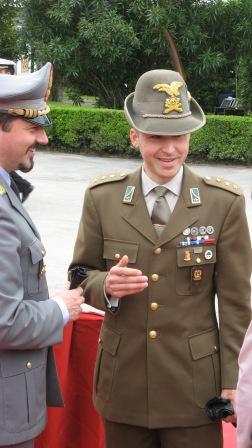
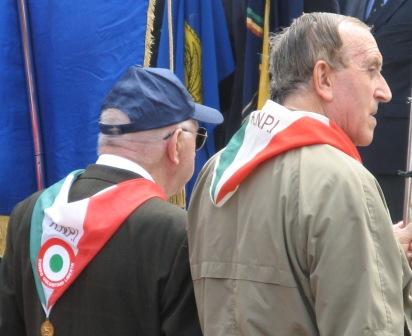
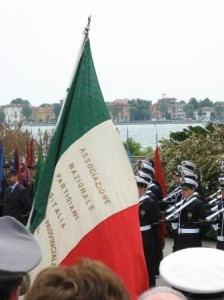

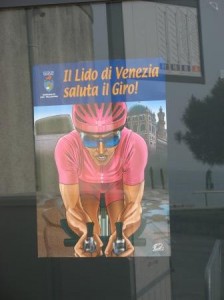
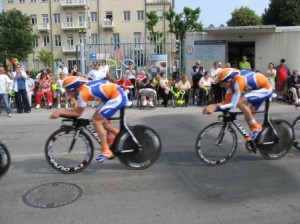
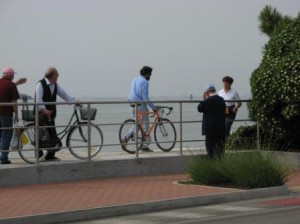
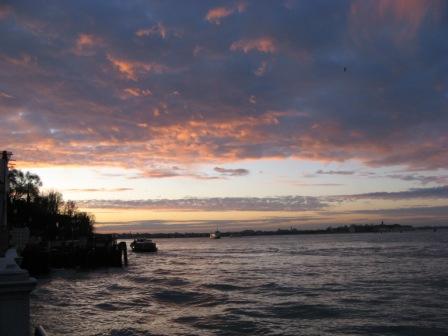
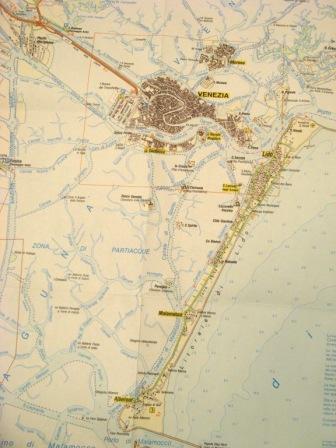

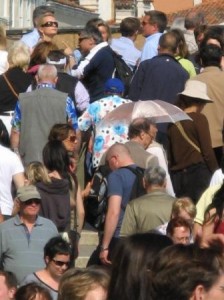
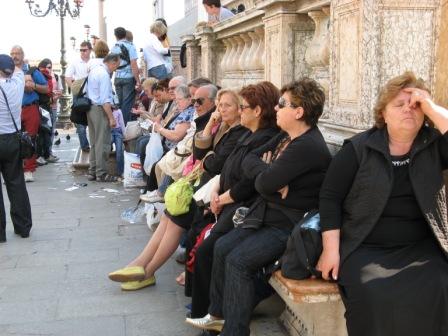 It would be an impressive spiritual exercise for anyone wanting to determine how much compassion they can feel toward their fellow humans to board the #1 local vaporetto line at Piazzale Roma on any Mayday (which amounts to virtually any day from May 1 to September 1) with their soul full of love for humankind, and then measure what’s left by the time they reach San Marco.
It would be an impressive spiritual exercise for anyone wanting to determine how much compassion they can feel toward their fellow humans to board the #1 local vaporetto line at Piazzale Roma on any Mayday (which amounts to virtually any day from May 1 to September 1) with their soul full of love for humankind, and then measure what’s left by the time they reach San Marco. 